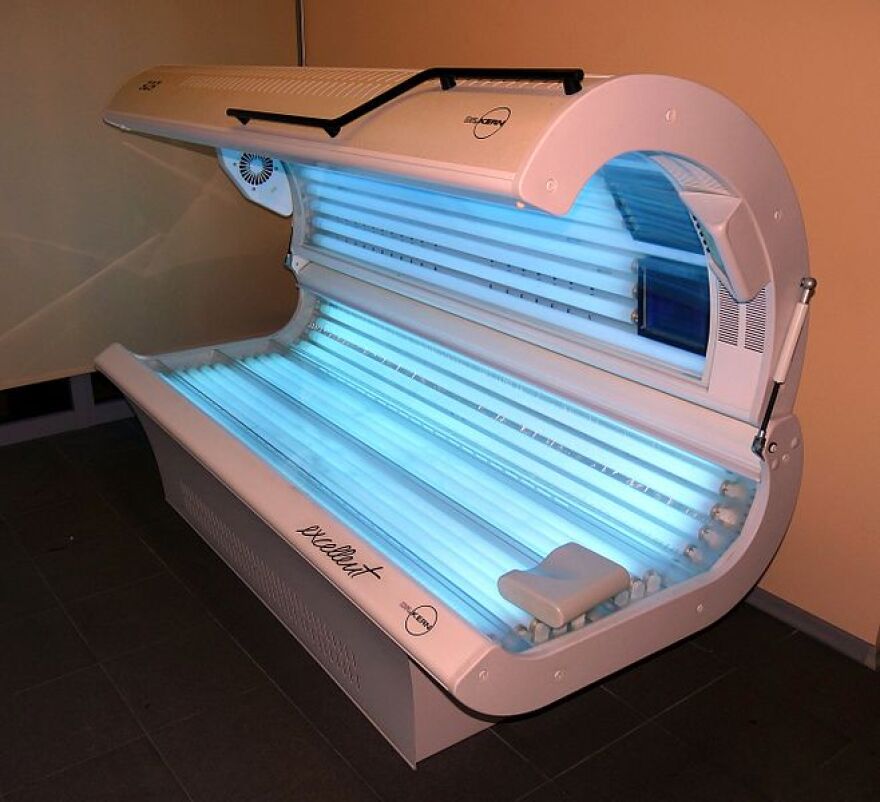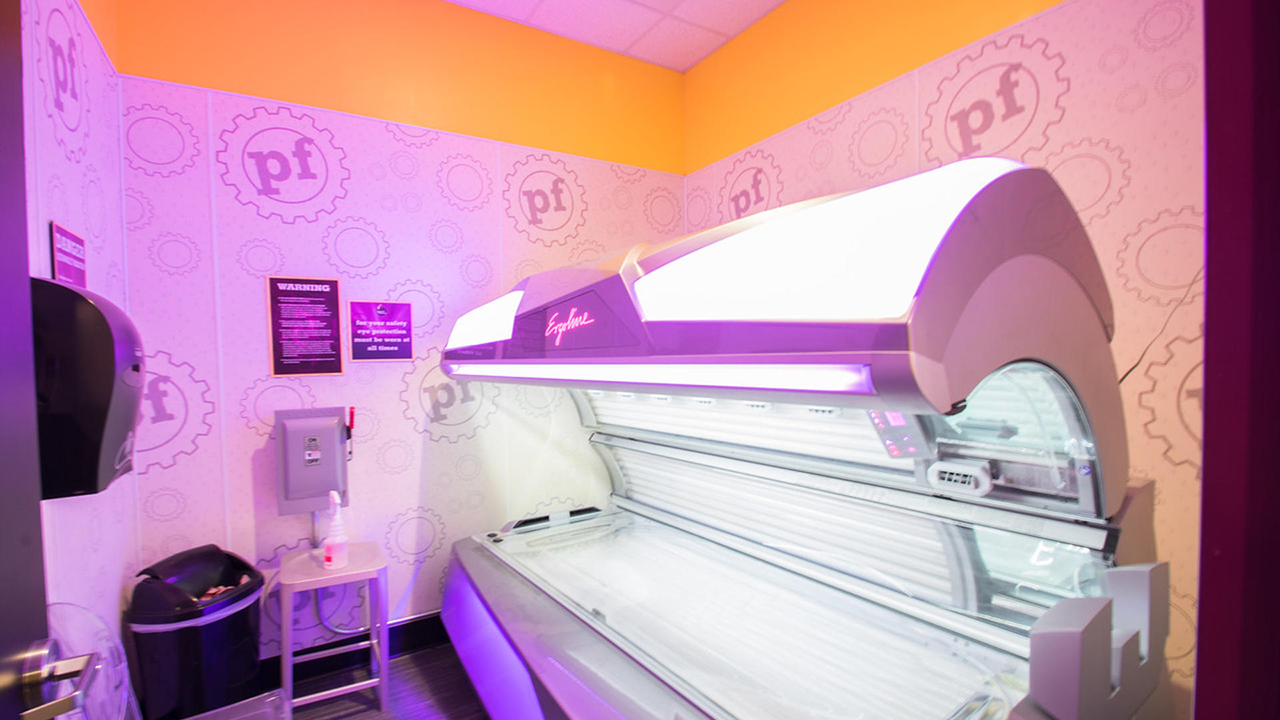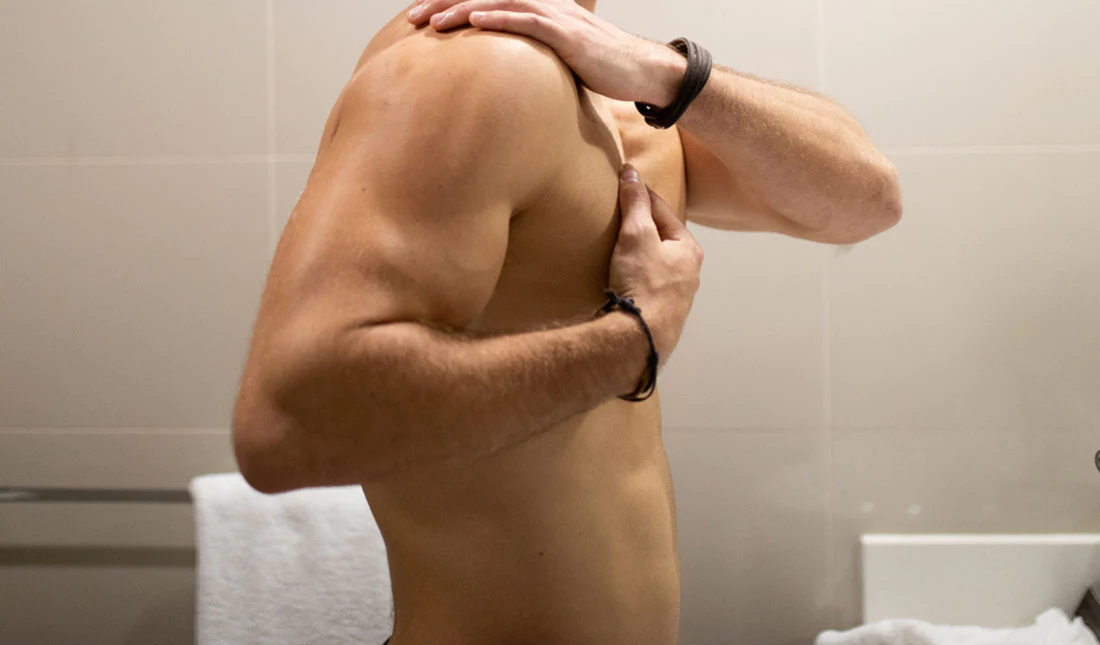The time you spend in the sun to get a tan depends on things like your skin type, how strong the sunlight is, and how sensitive you are to it.
Remember, too much time in the sun can harm your skin and make the chance of getting skin cancer higher. So, be careful when you’re trying to get a tan.
Suppose you’re using a tanning bed with UV lamps. In that case, the American Academy of Dermatology recommends starting with a short exposure time, such as 3-4 minutes, and gradually increasing it based on your skin’s response.
Limiting UV exposure to no more than 10-15 minutes per session is generally advised. People with fair or sensitive skin may need even shorter exposure times.
Here are some general guidelines:
- Skin Type: Individuals with fair or sensitive skin should have shorter exposure times compared to those with darker or less sensitive skin.
- Tanning Bed Intensity: The power of tanning bed lamps can vary. Higher-intensity beds may require shorter exposure times.
- Previous Tanning Experience: If you’re new to tanning, start with shorter sessions to allow your skin to acclimate.
- Use of Tanning Lotions: Using indoor tanning lotions can help enhance the tanning process and protect your skin. Some lotions also contain moisturizers to prevent excessive drying of the skin.
Understanding UV Intensity Levels

Understanding UV intensity levels in tanning beds is crucial for ensuring safe and effective tanning experiences. UV intensity is typically categorized into low, medium, and high levels, each affecting the skin differently.
Additionally, the impact of intensity on recommended exposure times is a key consideration for minimizing the risk of sunburn and other skin damage.
Differentiating between low, medium, and high-intensity UV beds:
Low-intensity UV beds:
- Emit lower levels of UV radiation.
- Suited for individuals with fair or sensitive skin.
- Gradual tan development, requiring more sessions for noticeable results.
- Lower risk of burning but may necessitate longer exposure times.
Medium-intensity UV beds:
- Strike a balance between low and high-intensity beds.
- Suitable for individuals with a moderate skin type.
- Typically, this results in a faster tan compared to low-intensity beds.
- There is a moderate risk of burning; exposure times need to be monitored.
High-intensity UV beds:
- Emit higher levels of UV radiation for quicker tanning.
- Recommended for experienced tanners with a darker skin type.
- Faster than development but higher risk of sunburn.
- Shorter exposure times are advised to prevent skin damage.
Impact of intensity on recommended exposure times:
Low-intensity beds:
- Longer exposure times may be necessary to achieve a tan.
- Reduced risk of burning allows for extended sessions.
- Regular monitoring of skin conditions is still crucial.
Medium-intensity beds:
- Moderate exposure times for a balance between tan development and safety.
- Skin monitoring remains important to prevent overexposure.
High-intensity beds:
- Shorter exposure times are recommended due to increased UV output.
- Caution is essential to avoid sunburn and other skin issues.
- Regular breaks and skin assessments during sessions are advisable.
General Tips:
- Skin Type Assessment: Consider individual skin types (Fitzpatrick skin types) when choosing the appropriate UV intensity.
- Build-up Gradually: Start with shorter exposure times and gradually increase to avoid overexposure and skin damage.
- Protective Measures: Always use appropriate eyewear and skin lotions to minimize the risk of eye damage and dehydration.
Determining Skin Type
Overview of the Fitzpatrick Scale for Classifying Skin Types:
The Fitzpatrick Scale is a way of categorizing your skin type using numbers. It looks at things like your skin color, how your skin reacts to the sun, and whether you’re more likely to burn or tan.
The scale, developed by dermatologist Thomas Fitzpatrick, categorizes skin into six types:
Type I:
- Characteristics: Very fair skin, often with red or blonde hair and blue or green eyes.
- Reaction to Sun: Always burns, never tans.
- Examples: Individuals with Celtic or Northern European ancestry.
Type II:
- Characteristics: Fair skin, often with light hair and light-colored eyes.
- Reaction to Sun: Burns easily, tans minimally.
- Examples: Individuals of European descent.
Type III:
- Characteristics: Fair to beige skin, often with darker hair and eyes.
- Reaction to Sun: Burns moderately, tans gradually.
- Examples: Individuals of Southern European or Latin American descent.
Type IV:
- Characteristics: Olive or light brown skin, often with dark hair and eyes.
- Reaction to Sun: Burns minimally, tans well.
- Examples: Individuals of Mediterranean, Middle Eastern, or Asian descent.
Type V:
- Characteristics: Brown skin, often with dark hair and eyes.
- Reaction to Sun: Rarely burns, tans easily.
- Examples: Individuals of Middle Eastern, Indian, or Latino descent.
Type VI:
- Characteristics: Very dark brown to black skin, often with dark hair and eyes.
- Reaction to Sun: Rarely burns, tans easily.
- Examples: Individuals of African, African-American, or Afro-Caribbean descent.
Tailoring Tanning Duration Based on Individual Skin Sensitivity:
Type I and II:
Recommendations:
- Start with very short exposure times.
- Gradually increase session duration to minimize the risk of burning.
- Consider using low-intensity tanning beds.
Type III and IV:
Recommendations:
- Begin with moderate exposure times.
- Monitor skin response and adjust duration accordingly.
- Medium to high-intensity beds may be suitable.
Type V and VI:
Recommendations:
- Start with moderate exposure times.
- Tanning beds with higher intensity may be appropriate.
- Caution is still advised to prevent overexposure.
General Tips:
- Always follow professional advice and adhere to recommended exposure guidelines.
- Use appropriate protective measures such as eyewear and skin lotions.
- Regularly assess skin condition and adjust tanning duration accordingly.
- Avoid consecutive sessions to allow the skin to recover.
Manufacturer Guidelines
Importance of Following Specific Instructions Provided by the Tanning Bed Manufacturer:
Safety and Effectiveness:
- The manufacturer’s guidelines are designed to ensure the safe and effective use of the tanning bed.
- Deviating from these instructions may increase the risk of skin damage, burns, and other adverse effects.
Equipment Performance:
- Adhering to manufacturer guidelines helps maintain the optimal performance of the tanning bed.
- Following recommended practices ensures that the equipment functions as intended, providing consistent and reliable results.
Warranty Compliance:
- Failure to follow manufacturer guidelines may void the warranty of the tanning bed.
- Adhering to instructions ensures safety and protects the investment in the equipment.
User Experience:
- Manufacturers often provide guidelines to enhance the overall user experience.
- Following these recommendations can contribute to achieving the desired tan without compromising skin health.
Adjusting Exposure Times According to the Bed’s Specifications:
Understand Bed Specifications:
- Familiarize yourself with the specific features and specifications of the tanning bed.
- Take note of details such as bulb type, wattage, and recommended usage.
Consider UV Intensity:
- Different beds may have varying UV intensities, affecting the recommended exposure times.
- Low–, medium, and high-intensity beds require different durations to achieve desired results without overexposure.
Factor in Session Frequency:
- Some beds may have guidelines on the frequency of tanning sessions.
- Adhering to these recommendations helps prevent overuse and allows the skin to recover between sessions.
Monitor Bulb Condition:
- Regularly check the condition of tanning bed bulbs.
- Replace bulbs as recommended by the manufacturer to maintain consistent UV output.
Individualize Exposure Times:
- Consider individual factors such as skin type, tanning history, and sensitivity.
- Adjust exposure times based on these factors while staying within the limits set by the manufacturer.
Temperature and Ventilation:
- Certain tanning beds may provide guidelines specifying optimal room temperature and ventilation.
- Adherence to these recommendations guarantees a comfortable and secure tanning environment.
Regular Maintenance:
- Follow the manufacturer’s guidelines for routine maintenance and cleaning.
- Regular upkeep contributes to the longevity and performance of the tanning bed.
Monitoring Skin Response
Importance of Paying Attention to Skin Reactions During and After Tanning:
Preventing Sunburn and Damage:
- Regular monitoring of skin reactions during tanning helps prevent overexposure and sunburn.
- Early detection allows for adjustments in exposure times to avoid damage to the skin.
Individualized Approach:
- Each person’s skin reacts differently to UV exposure.
- Paying attention to skin response allows individuals to tailor their tanning sessions based on their unique sensitivity and tolerance levels.
Customizing Tanning Plans:
- Individuals can customize their tanning plans by observing how the skin responds to achieve a gradual and healthy tan.
- Adjustments can be made in exposure times, frequency of sessions, and use of protective measures.
Skin Health Assessment:
- Monitoring the skin promotes overall skin health.
- Changes in skin texture color or the development of unusual moles can be noticed early, prompting individuals to seek medical advice if necessary.
Ensuring Even Tan Development:
- Paying attention to skin response helps in achieving an even and natural tan.
- Adjustments can be made to address uneven tan lines or areas that may be more prone to burning.
Signs of Overexposure and How to Address Them:
Redness and Irritation:
Signs:
- Skin becomes excessively red or irritated.
Address:
- Immediately discontinue tanning.
- Put aloe vera or a gentle lotion on your skin to make it feel calm.
- Allow the skin to fully recover before resuming tanning.
Itchiness or Dryness:
Signs:
- Skin feels excessively dry or itchy.
Address:
- Moisturize the skin regularly to restore hydration.
- Reduce tanning frequency until the skin improves.
Peeling:
Signs:
- Skin begins to peel, indicating potential damage.
Address:
- Discontinue tanning until the skin has fully healed.
- Use a gentle exfoliator to aid in the removal of peeling skin.
Blistering or Severe Pain:
Signs:
- Formation of blisters or severe pain.
Address:
- Seek medical attention immediately.
- Avoid further UV exposure until the skin has healed.
Changes in Mole Appearance:
Signs:
- Noticeable changes in the color, size, or shape of moles.
Address:
- Consult a dermatologist promptly for a skin examination.
Eye Irritation or Discomfort:
Signs:
- Irritation, redness, or discomfort in the eyes.
Address:
- Use proper protective eyewear during tanning sessions.
- If symptoms persist, seek medical attention.
Using Protective Measures

The Role of Tanning Lotions with SPF in Preventing Sunburn:
UV Protection:
- Tanning lotions that have Sun Protection Factor (SPF) create a shield to guard against the bad effects of UV radiation.
- SPF helps to prevent sunburn by reducing the penetration of UVB rays into the skin.
Moisturization:
- Many tanning lotions include moisturizing agents that keep the skin hydrated.
- Well-hydrated skin is less prone to dryness, peeling, and irritation, enhancing the overall tanning experience.
Enhanced Tanning Results:
- Some tanning lotions are specifically formulated to enhance the tanning process.
- Ingredients like bronzers or accelerators stimulate melanin production, promoting a faster and more even tan.
Longer-Lasting Tan:
- By protecting the skin from overexposure and sunburn, tanning lotions with SPF contribute to the longevity of the tan.
- Healthy, undamaged skin retains a tan for a more extended period.
Preventing Premature Aging:
- Regular use of SPF-containing tanning lotions helps prevent premature aging of the skin.
- UV radiation is a leading cause of wrinkles, fine lines, and other signs of aging.
Choosing the Right SPF:
- Select a tanning lotion with an appropriate SPF based on skin type and tanning goals.
- Higher SPF is recommended for fair or sensitive skin, while lower SPF may suit darker skin.
Keep your eyes safe from UV
- rays by wearing protective glasses. UV rays can hurt your eyes, causing problems like photokeratitis or long-term issues such as cataract
- s.
Compliance with Safety Standards:
- Many tanning facilities require the use of protective eyewear to comply with safety regulations.
- Adhering to these guidelines is essential for preventing eye injuries and ensuring a safe tanning environment.
UV-Blocking Lenses:
- Protective eyewear for tanning typically features lenses blocking UVA and UVB rays.
- This prevents the risk of eye irritation, redness, and long-term damage caused by UV exposure.
Comfortable Tanning Experience:
- Proper eyewear provides a comfortable and enjoyable tanning experience.
- It protects the eyes from the brightness of tanning lamps and eliminates the need to squint during sessions.
Customized Fit:
- Eyewear designed for tanning comes in various styles and sizes to accommodate different face shapes.
- Ensuring a proper fit enhances both comfort and effectiveness.
Avoiding Unintended Consequences:
- Squinting or closing the eyes during tanning can lead to uneven tan lines or unwanted pressure on the eyes.
- Protective eyewear eliminates these issues, allowing for a more even and relaxed tanning experience.
Alternatives and Considerations
Exploring Sunless Tanning Options:
Sunless Tanning Products:
- Self-tanning lotions, creams, and sprays offer an alternative to UV exposure for achieving a tan.
- These products typically contain dihydroxyacetone (DHA), which interacts with the skin to produce a temporary tan without UV radiation.
Spray Tanning:
- Spray tanning involves the application of a tanning solution to the skin through a spray gun or booth.
- This method provides a quick and even tan without UV exposure and is often used for special occasions.
Tanning Wipes and Patches:
- Tanning wipes or patches are convenient options for targeted tan application.
- They are designed for specific areas of the body and offer control over the tanning process.
Bronzing Makeup:
- Bronzing makeup products can provide a temporary tan for the face and body.
- These products wash off easily and are suitable for those looking for a short-term tan.
Gradual Tanning Moisturizers:
- Moisturizers with gradual tanning properties allow for a subtle tan to develop over time.
- These products are suitable for individuals who prefer a more gradual and natural-looking tan.
Professional Airbrush Tanning:
- Professional airbrush tanning involves a technician applying a tanning solution using an airbrush gun.
- This method allows for a customized and even tan, with the technician adjusting the intensity based on individual preferences.
Considering the Potential Risks and Benefits of UV Tanning:
Benefits of UV Tanning:
Vitamin D Synthesis:
- Moderate exposure to UVB rays can stimulate vitamin D production in the skin.
- Getting enough Vitamin D is crucial to keep your bones strong and ensure you feel well overall.
Psychological Benefits:
- Some individuals find that exposure to UV light can have mood-enhancing effects, potentially alleviating symptoms of seasonal affective disorder (SAD).
Faster Results:
- UV tanning can produce a tan more quickly compared to sunless tanning options.
Risks and Considerations:
Skin Damage:
- Spending too much time in the sun can give you sunburn, age faster, and increase the chance of getting skin cancer.
- People with lighter skin, those who got sunburned before, or those with family members who had skin cancer have a higher risk.
Eye Damage:
- UV rays can cause eye damage, including photokeratitis and cataracts.
- Proper protective eyewear is crucial to prevent eye injuries during UV tanning.
Uneven Tan Lines:
- UV tanning may result in uneven tan lines, especially if protective measures are not used consistently.
Addiction and Overuse:
- Some individuals may develop a dependence on tanning, leading to overuse and an increased risk of skin damage.
Age Considerations:
- Younger individuals are more susceptible to the long-term effects of UV exposure, making it important to exercise caution and adhere to recommended guidelines.
Balancing Choices:
- You should think about the good and bad things about UV tanning.
- Trying other options, like sunless tanning, can be a safer way to get a tan without the possible harm from UV rays.
Using UV Tanning Responsibly:
- Choosing UV tanning, following recommended exposure guidelines, using protective measures, and monitoring skin response is crucial for minimizing risks.
Post-Tanning Care
Aftercare Tips to Prolong the Life of the Tan:
Moisturize Regularly:
- Hydrated skin retains a tan more effectively. Use a moisturizer with no alcohol content to prevent dryness.
- Apply moisturizer immediately after tanning and continue daily to maintain skin hydration.
Avoid Hot Showers and Baths:
- Using hot water can take away the natural oils from your skin and make your tan fade faster.
- Opt for lukewarm showers and baths to preserve the tan.
Use Mild Cleansers:
- Choose gentle, sulfate-free cleansers to avoid stripping the skin of its natural oils.
- Harsh soaps can contribute to the premature fading of the tan.
Pat Dry, Don’t Rub:
- After you shower, softly pat your skin dry with a towel instead of rubbing
- too hard. This gentle patting keeps your tan and stops the skin from coming off.
Avoid Exfoliation:
- Refrain from using harsh exfoliants immediately after tanning.
- Exfoliating can accelerate the fading of the tan, so use mild products and exfoliate sparingly.
Limit Chlorine Exposure:
- Chlorine in swimming pools can contribute to faster tan fading.
- Shower and apply a waterproof sunscreen before swimming to create a protective barrier.
Protect Against UV Exposure:
- After tanning, continue to use sunscreen when exposed to natural sunlight.
- Sunscreen with a suitable SPF helps prevent overexposure and extends the life of the tan.
Treating and Soothing Any Potential Skin Irritation:
Aloe Vera Gel:
- If the skin becomes irritated or red, apply aloe vera gel to soothe and cool the affected area.
Cool Compress:
- For sunburn or irritation, apply a cool compress to alleviate discomfort.
- Avoid using ice directly on the skin; wrap it in a cloth before applying.
Hydrocortisone Cream:
- For itching or inflammation, a hydrocortisone cream can provide relief.
- Use it according to the product instructions and avoid overuse.
Avoid Scratching:
- Resist the urge to scratch irritated skin, as this can worsen the condition and potentially damage the tan.
- If itching persists, consult a healthcare professional.
Antihistamines:
- If the skin reaction includes itching, consider taking an over-the-counter antihistamine.
Keep the Skin Hydrated:
- Dry, irritated skin can exacerbate discomfort.
- Continue to moisturize the skin regularly to maintain hydration and alleviate dryness.
FAQs
What is the ideal time for fair skin compared to darker skin?
Fair skin is more prone to burning, so individuals with fair skin should start with shorter sessions, typically around 5-10 minutes, while those with darker skin may tolerate longer sessions.
Can I tan for the same duration every session?
Adjusting your tanning time based on how your skin responds is essential. If you notice any redness or irritation, reduce the time, and always follow the guidelines provided by the tanning salon.
How often should I tan to maintain a tan?
Tanning frequency depends on personal preferences and skin sensitivity. Some people tan every 2-3 days, while others prefer a weekly schedule. Overexposure can lead to skin damage, so moderation is key.
Is there a maximum recommended time for UV tanning?
Most experts advise against exceeding 20 minutes in a single tanning session. Prolonged exposure increases the risk of burns and skin damage.
Can I use sunscreen in a tanning bed to protect my skin?
Using sunscreen in a tanning bed is not recommended, as it can interfere with the tanning process. Tanning lotions specifically designed for indoor tanning are preferable.
What impact does the type of tanning bed have on session duration?
High-pressure beds often require shorter sessions compared to low-pressure beds. Always follow the guidelines provided by the tanning salon for each specific bed.
Can medications affect the recommended tanning time?
Certain medications can increase sensitivity to UV rays, making your skin more susceptible to burns. Consult your doctor and inform your tanning salon of any medications you take.
Is it safe to tan for longer periods to achieve a darker tan quickly?
Yes, it’s safe to tan for longer periods to achieve a darker tan quickly.
Frankly, tanning for extended periods doesn’t necessarily result in a darker tan but significantly increases the risk of skin damage. Gradual exposure is safer and more effective.
How long should I wait between outdoor and indoor tanning sessions?
It’s advisable to wait at least 48 hours between outdoor and indoor tanning sessions to prevent overexposure and reduce the risk of skin damage.
Are there any signs that indicate I’ve tanned for too long?
Redness, itching, or tenderness indicate the signs of overexposure. If you notice these symptoms, reduce your tanning time and give your skin time to recover. If symptoms persist, consult a healthcare professional.
Conclusion
In conclusion, achieving and maintaining a healthy tan involves a combination of responsible practices before, during, and after the tanning process.
Understanding individual skin types, following manufacturer guidelines, using protective measures, and considering alternative tanning options contribute to a safer and more enjoyable experience.
Post-tanning care, including proper moisturization and addressing any skin irritation, is essential for prolonging the life of the tan and promoting overall skin health.
Ultimately, making informed decisions, prioritizing skin safety, and seeking professional advice when needed are key elements of responsible tanning practices.








